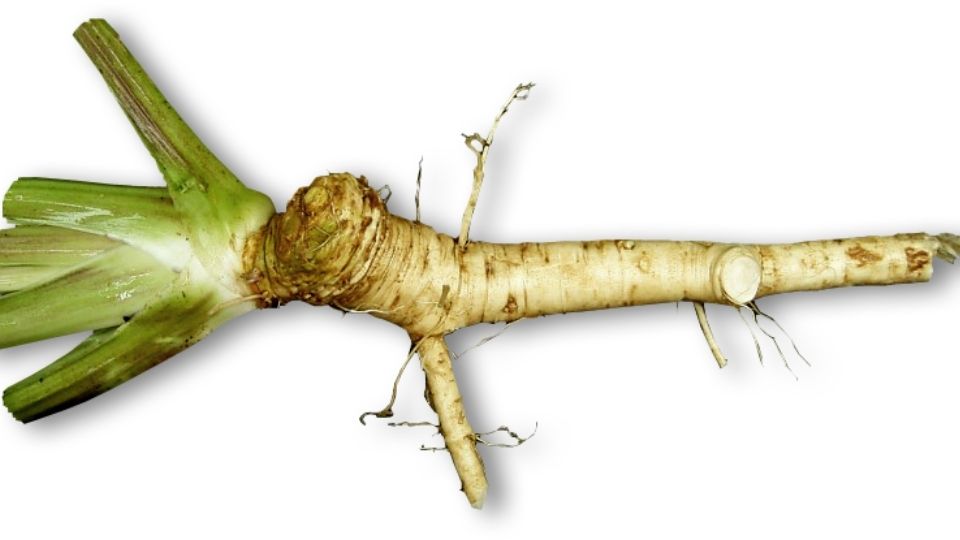“The radish is worth its weight in lead, the beet its weight in silver, the horseradish its weight in gold.” – The Delphic Oracle to Apollo
Hotcha cha! Americans have an insatiable craving for hot stuff. 56% of all American households have some kind of hot sauce on the shelf. But there’s lots of culinary real estate beyond salsa, wasabi, and hot sauce.
Horseradish (which simply means “large root”), for example. If you’re into the tingly and curative in your kitchen, that sassy-tasting root offers extensive health, culinary and live-longer benefits that wildly outpace anything Tabasco can offer.
This largely sidetracked root vegetable (a member of the mustard family) has quite a pedigree. The Egyptians used horseradish as far back as 1500 B.C. Greeks used it as a kind of Ben Gay rub (as well as an aphrodisiac). It was on the Passover Seders table as one of the bitter herbs. In a precursor to Sudafed, horseradish syrup was a widely used expectorant cough medicine. You name it, horseradish as a salve, syrup, tea or poultice probably was used as a cure for something. During the Renaissance, horseradish use spread from Central Europe to Scandinavia and westward. By the 1600s, the British were eating their beef and oysters with it. The root with the kick was even grown at inns and coach stations, and used to make pick-me-ups for weary travelers. Early settlers brought horseradish (along with porridge and pot pies) to North America. Today, approximately 6 million gallons of prepared horseradish are produced annually in the U.S.; that can generously season enough sandwiches to wrap 12 times around the world (according to the website horseradish.org).
And with good reason. Nutritionally, horseradish has it all.
This less-popular cruciferous vegetable (cousin to broccoli, kale, and cauliflower) provides ten times more of the anti-cancer glucosinolates than broccoli, plus various plant compounds that protect against DNA cell damage, while the oils in horseradish are both antibacterial and antimicrobial. There are enzymes in horseradish that aid in digestion, elimination, and the health of the gallbladder which then helps with the removal of toxins. Horseradish also supplies vitamin C, zinc, potassium, magnesium, and folates, all nutrients your immune system needs to keep humming along.
If you’re ready to season a sub, concoct a knock-your-socks-off dip, or an unforgettable salad dressing, grab a fresh root from your local farmer’s market or natural foods market (horseradish root is sometimes confused with celery root, although horseradish is larger and more angular. When in doubt, ask). Spring is the best time to buy.
Basic Horseradish Recipe
Use a vegetable peeler to strip away the tough outer skin. The “meat” inside should be smooth and white. You’ll need a sharp chef’s knife to chop the root into small chunks. Add 2 cups of root to a food processor with 4 Tbs (or more to taste) of white or rice wine vinegar, plus 2 teaspoons of salt. Note: A little sugar is optional. Also optional, a tablespoon or two of plain yogurt to make the resulting product even smoother. Process until fluffy.
Variations:
CARROT-CILANTRO HORSERADISH
Process as above, but add finely grated fresh carrot and chopped cilantro before processing.
MINTY FRESH HORSERADISH
Add a bunch of fresh mint and 1-2 tablespoons of chopped fresh rosemary to the basic recipe.
OTHER USES FOR HORSERADISH
- Horseradish wakes up salad dressings (add a bit to your oil and vinegar or Caesar salad dressing) and plain soups
- Toss it (with a little olive oil) into cooked vegetables and steamed rice or quinoa
- Stir a small amount into your basic hummus or mayonnaise
- Try a dab in a dish of pineapple or applesauce!
- Lace your whipped or mashed potatoes with a spoonful, plus some chopped chives or minced parsley
- Blend a bit of horseradish into bought or homemade pesto
- Add to pasta sauce
- Blend into egg or tuna salad
- Add to dairy or non-dairy cottage cheese, or sour cream for a zippy chip dip.
- Mix with thick yogurt and use in place of butter on sandwich bread or rolls
Can’t find a root? Don’t throw in the towel. You don’t have to start from scratch. You can just buy a jar of the plain old prepared horseradish (read labels. Avoid products with anything more than salt and vinegar added) and take it from there. Less work, pretty much the same benefits.
-Frances Goulart
Image: Wikimedia Commons




After several decades of abstaining from this root, a year ago a certain culinary expert introed me to eight variations of the theme (freshly prepared, granular-soft and subtly infused with 5-8 ingredients that enhanced the overall taste.) Great as a spread/sauce over tuber chips from TJ’s or WF market. Adventuresome preparers can tweak the end product to consumer tastes: beginnner, low-octane, take-the-plungers followed by the intermediate version with notable bite and symphony of flavors and my fave! : the vaunted 93 octane, grown-man cry versions, the later guaranteed to clear nasal passages for the duration. Lotta good tears. Interesting changes noted in the “bodily overall “ led by digestion via a steady root diet so all are encouraged to partake. Gentle disagreement about alternatively buying processed on the shelf varieties. Thanks anyway. I will take my Ferrari over a scooter any day.